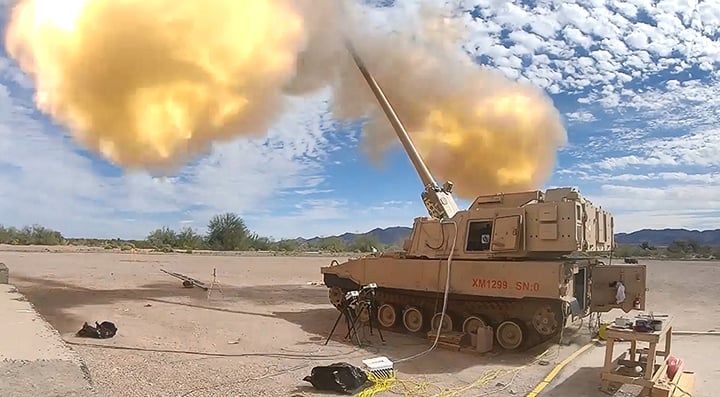
A photo of an early Extended Range Cannon Artillery platform prototype. (US Army)
WASHINGTON — The US Army is grappling with just what mix of artillery capabilities it needs in its future arsenal, and industry is expected to catch a glimpse of that plan by the time the Biden administration delivers its budget request to Congress next year, according to a senior service official.
The analysis, also dubbed the tactical fires study, is expected to be wrapped up in time to help Army leaders sort through funding decisions before their fiscal 2025 budget request is finished, service acquisition head Doug Bush told Breaking Defense and another outlet on Oct. 11. That budget is traditionally delivered to Capitol Hill after early February.
“We’re going to get that [study] in time to inform our finishing of the [FY]25 budget,” he said. “So, that is when you might see an output of what the strategy and the study tells us.”
The Army currently has a mix of towed and wheeled cannons in its portfolio. But with lessons learned from Ukraine and an eye on the Pacific, the service has a number of different modernization efforts underway, including under its Extended Range Cannon Artillery (ERCA) program. That program includes a mix of new munitions, a “supercharged” propellant and integration of a 30-foot, 58-caliber gun tube onto BAE Systems’ Paladin M109A7 self-propelled howitzer. The goal: launch 155-mm rounds out to 70 km, an increase from the current max range of up to 30 km.
However, ERCA platform development has encountered technical challenges during live fire testing, including excessive wear and tear on the cannon, and the Army needs to decide if it will move into production, revamp the design or abandon the platform for now. Bush explained that ERCA “difficulties” simply placed more “urgency” on the fires community to wrap up that comprehensive study.
“I’ve worked over the summer to try to kind of understand [all the parts of ERCA] in terms of time and costs to address them simultaneously,” he said.
“If the… 58-cal cannon solution can’t deliver on a timeline we want, what are the other options?” Bush later added. “That can be munitions…new munitions with old cannons and it can be different cannons.”
The study is also sorting through the wheeled versus towed artillery debate, in part because the latter has limitations but lighter units still need protection. While there are questions about just how much and which formations to place towed artillery, Bush said the service is also looking at using 120-millimeter mortars for lighter formations.
“With the right ammunition, get you very similar capability to a 105-mm,” he said, referring to a towed howitzer. “Does that make sense for light units?”
Options Abound
While options remain publicly fluid, Bush pointed towards what he said were several options for new 52-caliber cannons. One such option was on display at the Association of the United States Army (AUSA) conference in Washington, DC earlier this month: BAE Systems’ M109-52 prototype, which takes the Rheinmetall L52 main gun and integrates it onto an M109A7 howitzer.
Dan Furber, BAE’s Combat Mission Systems director of ground vehicle production, told Breaking Defense on Oct. 11 that the company has been working on the design for almost 18 months. Then this September, it was used for a direct fire demo on a “very short range.” The plan, he said, is to continue testing and produce a prototype that can hit targets out to the 60-kilometers range.
“I’m targeting the armored brigade combat team commander and their fight,” Furber said. “We really looked at augmenting the M109A7…. commanders [have] sensors that can look out to 60 kilometers and with the A7 they can only shoot out to 30: I’m trying to fill that gap.”
In addition to whole new platforms, the Army’s study is looking at a cheaper solution that could add capability to existing platforms: new, updated munitions.
As one example of the work in that area, Bush highlighted a new 155-mm round developed under the ERCA umbrella called the XM1155, which could be a candidate for “acceleration.”
“One way to get the range, perhaps sooner, would be munitions focused modernization now versus the cannon which can come later,” he added. “I think [XM]1155 is, in my view, worth pursuing. We just have to line up the requirement and then line up the money, but I think it makes sense.”
Two teams working on that new munition are moving ahead with development touting their progress: BAE and Boeing, with the latter partnered with Nammo on the project. Boeing’s shell is propelled by an airbreathing jet engine, whereas BAE’s uses standard propellants.
RTX was previously working on the weapon. However, a company spokesperson told Breaking Defense on Thursday that it “is not actively in the competition.”
A Fight Over Range
On the first day of the AUSA convention earlier this month, both BAE and Boeing published press releases touting record-breaking performances by their prospective XM1155 candidates, with BAE claiming a record for the “furthest distance an M109 Paladin ever fired a guided projectile.” BAE’s XM-1155-SC (sub-caliber) prototype was guided to its target by GPS, according to the release, and the shell’s goal was to hit “fixed and moving targets in contested environments at twice the range of existing cannon-launched precision guided munitions,” the company previously said.
Boeing too claimed its own record at the show, in its case for the “longest indirect fire test of a ramjet-powered artillery projectile” after its prototype launched from the ERCA platform. Boeing, which is partnered with Nammo on the project, said in the release that it previously set the same record in a test fire in December 2022, where that exercise used a 39-caliber cannon.
The confusing competing claims became more complicated when Jim Miller, BAE’s vice president of business development for combat mission systems, made bold assertions about BAE’s XM1155 shell in a briefing with reporters.
“We’re pretty confident we’ve got the record” for the M109 range, Miller added, emphasizing that the Army would have to perform the “tie break” on the assertion. Asked directly whether BAE believes they’ve beaten Boeing for the M109 record, Miller said, “We believe we did. Several times over. And we believe we’ve done it guided and they have not.”
Asked about Miller’s comments, a BAE spokesperson said “Our XM1155-SC test in April 2023 was fired from a tactically representative M109A6 (39 caliber length 155mm) using MACS [modular artillery charge system] Zone 5 and guided to and impacted the target. To the best of our knowledge, the XM1155-SC went further than any round fired from an M109.”
The BAE spokesperson also said that the company’s design “has proven success without special propellant charges and is capable of reaching extended ranges with current and future planned US Army armament systems. XM1155-SC is currently and will remain compatible with existing Army validated and tested propellant charges designed to meet barrel wear and firing rate requirements.”
Given available evidence, it’s difficult to compare the performance of the two defense giants. Without the raw ranges, which must be provided by the Army, it’s not clear which company’s shell may be capable of greater distance. And unless the Army discloses how each company’s prototype measures up to the service’s criteria, which is unlikely especially as the prototyping program is still ongoing, performance for other potential factors like precision and maintenance needs will remain unclear.
An Army spokesperson did not return Breaking Defense’s requests for comment.
For its part, Boeing plans to integrate Joint Direct Attack Munition (JDAM) precision guidance technology for a future test, and when asked about BAE’s claims, a Boeing executive told Breaking Defense that range limitations prevented the company’s offering from going its full distance for the test announced at AUSA.
“We went to the physical limit of the range on this test. We have not shot at our maximum range yet,” said Jim Leary, executive director of business development for Boeing weapon systems.
Leary also highlighted what he said are the benefits of ramjet technology for reducing wear and tear on a platform — the logic being that “when heavy charges are used to boost traditional or sub-caliber munitions to achieve range increases, it can damage and reduce the lifecycle of cannons,” as opposed to a ramjet design “that requires much less charge” — as well as the “form factor” of a ramjet-powered shell that “gives it speed advantages that reduce time to target.
“We believe our offering is revolutionary, not just evolutionary, in artillery,” he added. “This is our ‘moon shoot’ for long-range precision fires and we’re proud of what we’ve been able to accomplish in this co-developmental program with the Army so far.”
Taking aim: Army leaders ponder mix of precision munitions vs conventional
Three four-star US Army generals this week weighed in with their opinions about finding the right balance between conventional and high-tech munitions – but the answers aren’t easy.


























